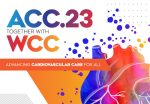Transcatheter aortic valve replacement has shown important benefits but one of its biggest challenges is showing its safety and efficacy at followup in low risk patients. At present we have 2-year data from the Evolute Low Risk, but the we lack information at longer followup. The study looked at 3-year followup of the Evolute Low<a href="https://solaci.org/en/2023/05/03/evolute-low-risk-at-3-years-promising-outcomes/" title="Read more" >...</a>
The most read scientific articles in interventional cardiology in February on our website
Below, we share February’s most read scientific abstracts in interventional cardiology at solaci.org. Can Drug Coated Balloon Be a Valid Option for Small Vessels? One of the challenges of percutaneous coronary interventions (PCI) are <2.5 mm vessels, since complications and restenosis complications rate are higher than with >3.0 mm vessels. Is Using Drug-Eluting Balloons and<a href="https://solaci.org/en/2023/03/22/the-most-read-scientific-articles-in-interventional-cardiology-in-february-on-our-website/" title="Read more" >...</a>
ACC 2023 | TAVR in Low Risk Patients: 3-Year Outcomes
At present, transcatheter aortic valve replacement (TAVR) has become the gold standard in the US, regardless surgical risk. The current ACC and AHA guidelines recommend that a Heart Team make the decision for 65 to 80-year-old patients with aortic stenosis. In low risk patients, fast recovery and short term benefits of TAVR should be weighed<a href="https://solaci.org/en/2023/03/08/acc-2023-tavr-in-low-risk-patients-3-year-outcomes/" title="Read more" >...</a>
Plaque Erosion with No Stenting in Acute Coronary Syndrome: Are There Event Predictors to Avoid This Strategy?
Event predictors in patients with plaque erosion and no stenting. A third of all acute coronary syndrome (ACS) cases are caused by plaque erosion. In the initial EROSION study, it was shown that patients with plaque erosion (as evidenced by OCT, with stenosis <70%, TIMI III flow, and asymptomatic) were stabilized without stent implantation (no<a href="https://solaci.org/en/2023/02/13/plaque-erosion-with-no-stenting-in-acute-coronary-syndrome-are-there-event-predictors-to-avoid-this-strategy/" title="Read more" >...</a>
FRAME-AMI: FFR vs. Angiography of Non-Culprit Vessel in ACS
This study compared fractional flow reserve (FFR) vs. angiography to guide the angioplasty of non-culprit vessels in patients with acute coronary syndrome (ACS) and multivessel disease. Landmark studies such as COMPLETE, COMPARE-ACUTE and DANAMI-3-PRIMULTI have demonstrated the prognostic value of revascularization (after treatment of the artery responsible for the ACS) of non-culprit arteries with respect<a href="https://solaci.org/en/2023/01/25/frame-ami-ffr-vs-angiography-of-non-culprit-vessel-in-acs/" title="Read more" >...</a>
Non-ST Elevation MI: How Long Do We Have for A Coronary Angiography?
This summary discusses the early invasive strategy and the risk of mortality in non-ST-elevation AMI. Over the past 2 decades, mortality and complications rates have seen a significant reduction thanks to technological and pharmaceutical development, and the increasing experience of health teams. This is especially true when we look at the use of coronary angiography<a href="https://solaci.org/en/2023/01/20/non-st-elevation-mi-how-long-do-we-have-for-a-coronary-angiography/" title="Read more" >...</a>
Intervention in Patients with Takayasu Arteritis: Rescue Therapy or an Alternative Complementary to Immunosuppressive Therapy?
Takayasu arteritis (TAK) is an uncommon granulomatous large-vessel vasculitis that affects the aorta and its primary branches. The most frequently types of observed vascular compromise are obstructive lesions, and aneurysmal vascular lesions or dissections. In 2021, the American College of Rheumatology recommended not to implement percutaneous intervention (PI) with these patients and only use immunosuppressive<a href="https://solaci.org/en/2023/01/18/intervention-in-patients-with-takayasu-arteritis-rescue-therapy-or-an-alternative-complementary-to-immunosuppressive-therapy/" title="Read more" >...</a>
Interventional cardiology: the most read articles of 2022 in solaci.org
Discover the most read scientific articles on interventional cardiology of 2022 in our website. The FDA Approves Intravascular Lithotripsy for Calcified Lesions The US Food and Drug Administration (FDA) has cleared the shockwave lithotripsy system to treat severely calcified plaque lesions. Is Epinephrine Superior to Adenosine in No-REFLOW? In patients with acute coronary syndrome, no-reflow prevalence is 32%. Different drugs—such as adenosine, verapamil,<a href="https://solaci.org/en/2023/01/05/interventional-cardiology-the-most-read-articles-of-2022-in-solaci-org/" title="Read more" >...</a>
Edge-to-Edge Repair Reduces Hospitalization and Mortality Rates in Secondary Mitral Valve Regurgitation?
Severe secondary mitral valve regurgitation is associated to hospitalization and mortality. The COAPT study has shown the superiority of guideline directed medical therapy at maximal tolerated doses according to guidelines (GDMT) plus edge-to-edge transcatheter repair (TEER) versus GMDT alone. However, at present there is no information on the impact of hospitalizations and their relationship to<a href="https://solaci.org/en/2022/11/22/edge-to-edge-repair-reduces-hospitalization-and-mortality-rates-in-secondary-mitral-valve-regurgitation/" title="Read more" >...</a>
Opening Ceremony SOLACI-SOCIME 2022
✔️ Opening Ceremony SOLACI-SOCIME 2022 ✔️ SOLACI-SOCIME 2022 Scientific Session 👨‍🏫 Content: 00:09 – Welcoming words – Dr. Guering Eid-Lidt (MEX) 01:41 – Fully understanding our TAVR implantation views and techniques – Dr. Ole de Backer (DNK) 21:51 – Transcatheter interventional heart failure therapies – Dr. Juan Granada (USA) 43:17 – The revolution in the<a href="https://solaci.org/en/2022/09/15/opening-ceremony-solaci-socime-2022-2/" title="Read more" >...</a>









